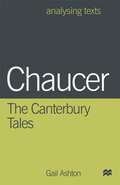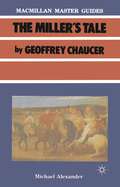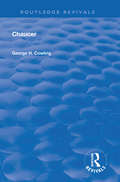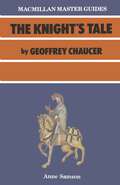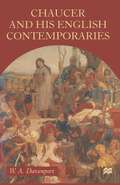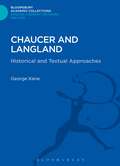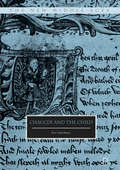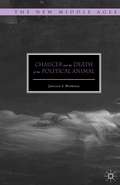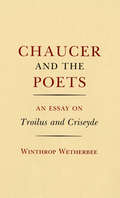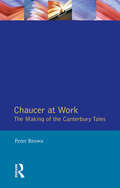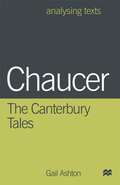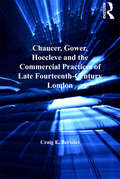- Table View
- List View
Chaucer: The Canterbury Tales (Analysing Texts)
by Gail AshtonDetailed textual analysis of the tales by the Miller, Nun's Priest, the Wife of Bath and the Pardoner, as well as the General Prologue invites you to sharpen your critical faculties, extend your knowledge and engage with the text itself in order to fully appreciate the work of this fascinating, complex and surprisingly modern writer. Whether you consider yourself an expert or a student, this study has something for you as it demonstrates the various approaches which can be used to learn about style, structure, multiple voices and the key themes of Chaucer's work. It offers a careful support and thoughtful framework upon which to base your own analysis and challenging you to form your own ideas and opinions.
Chaucer: Large Student Annotation Edition: Formatted With Wide Spacing And Margins And An Extra Page For Notes After Each Page Of Verse (pdf) (Palgrave Master Guides #Vol. 2)
by Geoffrey Chaucer Michael AlexanderAuthor Michael Alexander: Michael Alexander is Emeritus Professor of English Literature, University of St Andrews, UK. He is a poet and translator and has international experience of teaching English literature, both medieval and modern. Author Michael Alexander: Michael Alexander is Emeritus Professor of English Literature, University of St Andrews, UK. He is a poet and translator and has international experience of teaching English literature, both medieval and modern.
Chaucer: The Canterbury Tales (Longman Critical Readers)
by Geoffrey Chaucer Steve EllisThis new addition to the Longman Critical Readers Series provides an overview of the various ways in which modern critical theory has influenced Chaucer Studies over the last fifteen years. There is still a sense in the academic world, and in the wider literary community, that Medieval Studies are generally impervious to many of the questions that modern theory asks, and that it concerns itself only with traditional philological and historical issues. On the contrary, this book shows how Chaucer, specifically the Canterbury Tales, has been radically and excitingly 'opened up' by feminist, Lacanian, Bakhtinian, deconstructive, semiotic and anthropological theories to name but a few. The book provides an introduction to these new developments by anthologising some of the most important work in the field, including excerpts from book-length works, as well as articles from leading and innovative journals. The introduction to the volume examines in some detail the relation between the individual strengths of each of the above approaches and the ways in which a 'postmodernist' Chaucer is seen as reflecting them all.This convenient single volume collection of key critical analyses of Chaucer, which includes work from some journals and studies that are not always easily available, will be indispensable to students of Medieval Studies, Medieval Literature and Chaucer, as well as to general readers who seek to widen their understanding of the forces behind Chaucer's writing.
Chaucer: The Canterbury Tales (Longman Critical Readers)
by Geoffrey Chaucer Steve EllisThis new addition to the Longman Critical Readers Series provides an overview of the various ways in which modern critical theory has influenced Chaucer Studies over the last fifteen years. There is still a sense in the academic world, and in the wider literary community, that Medieval Studies are generally impervious to many of the questions that modern theory asks, and that it concerns itself only with traditional philological and historical issues. On the contrary, this book shows how Chaucer, specifically the Canterbury Tales, has been radically and excitingly 'opened up' by feminist, Lacanian, Bakhtinian, deconstructive, semiotic and anthropological theories to name but a few. The book provides an introduction to these new developments by anthologising some of the most important work in the field, including excerpts from book-length works, as well as articles from leading and innovative journals. The introduction to the volume examines in some detail the relation between the individual strengths of each of the above approaches and the ways in which a 'postmodernist' Chaucer is seen as reflecting them all.This convenient single volume collection of key critical analyses of Chaucer, which includes work from some journals and studies that are not always easily available, will be indispensable to students of Medieval Studies, Medieval Literature and Chaucer, as well as to general readers who seek to widen their understanding of the forces behind Chaucer's writing.
Chaucer (Routledge Revivals)
by George H. CowlingFirst Published in 1927, this volume provides a discourse on both the literary works of Chaucer, as well as Chaucer as a person, considering his mythology, and the various roles he fulfilled throughout his life.
Chaucer (Routledge Revivals)
by George H. CowlingFirst Published in 1927, this volume provides a discourse on both the literary works of Chaucer, as well as Chaucer as a person, considering his mythology, and the various roles he fulfilled throughout his life.
Chaucer: (pdf) (Bloomsbury Master Guides)
by Anne SamsonThis ebook is now available from Bloomsbury Academic. Bloomsbury Academic publish acclaimed resources for undergraduate and postgraduate courses across a broad range of subjects including Art & Visual Culture, Biblical Studies, Business & Management, Drama & Performance Studies, Economics, Education, Film & Media, History, Linguistics, Literary Studies, Philosophy, Politics & International Relations, Religious Studies, Social Work & Social Welfare, Study Skills and Theology. Visit bloomsbury.com for more information.
Chaucer and Boccaccio: Antiquity and Modernity
by R. EdwardsIn the late Middle Ages, Chaucer invents two imaginative domains crucial to his culture and to our understanding of the emergence of selfhood, subjectivity and social arrangements; antiquity and late-medieval modernity. Edwards demonstrates in this study how this was the result of Chaucer's reading and re-writing of the works of Boccaccio, which provide sources and models for portraying the classical past and medieval modernity. In so doing, Edwards provides us with a valuable way of assessing Chaucer's analysis of late medieval culture.
Chaucer and his English Contemporaries: Prologue and Tale in The Canterbury Tales
by Tony DavenportModern ways of presenting Chaucer have often made his work seem 'normal' so that The Canterbury Tales and its much-studied General Prologue are seen as archetypes of narrative and prologue. Tony Davenport argues that study of Chaucer's major work alongside contemporary English poems reveals the odd and extreme aspects of Chaucer's writing as well as the daring and experimental qualities in his work. The focus of the book is on strategies of narrative and discourse, but also includes discussion of other much-studied Middle English poems.
Chaucer and His Readers: Imagining the Author in Late-Medieval England
by Seth LererChallenging the view that the fifteenth century was the "Drab Age" of English literary history, Seth Lerer seeks to recover the late-medieval literary system that defined the canon of Chaucer's work and the canonical approaches to its understanding. Lerer shows how the poets, scribes, and printers of the period constructed Chaucer as the "poet laureate" and "father" of English verse. Chaucer appears throughout the fifteenth century as an adviser to kings and master of technique, and Lerer reveals the patterns of subjection, childishness, and inability that characterize the stance of Chaucer's imitators and his readers. In figures from the Canterbury Tales such as the abused Clerk, the boyish Squire, and the infantilized narrator of the "Tale of Sir Thopas," in the excuse-ridden narrator of Troilus and Criseyde, and in Chaucer's cursed Adam Scriveyn, the poet's inheritors found their oppressed personae. Through close readings of poetry from Lydgate to Skelton, detailed analysis of manuscript anthologies and early printed books, and inquiries into the political environments and the social contexts of bookmaking, Lerer charts the construction of a Chaucer unassailable in rhetorical prowess and political sanction, a Chaucer aureate and laureate.
Chaucer and Langland: Historical and Textual Approaches (Bloomsbury Academic Collections: English Literary Criticism)
by George KaneProfessor Kane is widely regarded as the leading middle English textual and literary scholar of our time and this collection of his essays will be widely welcomed. They focus largely upon the texts of Chaucer and Langland and demonstrate in an exemplary way how critical issues can arise from meticulous textual study.
Chaucer and the Canterbury Tales: A Short Introduction (Wiley Blackwell Introductions to Literature #48)
by John C. HirshThis concise and lively survey introduces students with no prior knowledge to Chaucer, and particularly to The Canterbury Tales. Provides essential facts about Chaucer, as well as a framework for thinking about his poetry. Encourages an engaged reading of The Canterbury Tales. Introduces students to the historical and religious background needed to understand the contexts in which Chaucer wrote. Provides essential facts about Chaucer, as well as a framework for thinking about his poetry. Encourages an engaged reading of The Canterbury Tales. Introduces students to the historical and religious background needed to understand the contexts in which Chaucer wrote.
Chaucer and the Child (The New Middle Ages)
by Eve SalisburyThis book addresses portrayals of children in a wide array of Chaucerian works. Situated within a larger discourse on childhood, Ages of Man theories, and debates about the status of the child in the late fourteenth century, Chaucer’s literary children—from infant to adolescent—offer a means by which to hear the voices of youth not prominently treated in social history. The readings in this study urge our attention to literary children, encouraging us to think more thoroughly about the Chaucerian collection from their perspectives. Eve Salisbury argues that the child is neither missing in the late Middle Ages nor in Chaucer’s work, but is,rather, fundamental to the institutions of the time and central to the poet’s concerns.
Chaucer and the Death of the Political Animal (The New Middle Ages)
by Jameson S. WorkmanDrawing from classical myth, the history of philosophy, literature, film, music, and painting, Workman connects the artistic claims of Chaucer and tests them against similar gestures in the history of philosophy and literature. What results is a radical retake on Chaucer as a philosopher and poet, upending any preconceived views.
Chaucer and the Norse and Celtic Worlds
by Rory McTurkThrough an examination of Old Norse and Celtic parallels to certain works of Chaucer, McTurk here identifies hitherto unrecognized sources for these works in early Irish tradition. He revives the idea that Chaucer visited Ireland between 1361 and 1366, placing new emphasis on the date of the enactment of the Statute of Kilkenny. Examining Chaucer’s House of Fame, McTurk uncovers parallels involving eagles, perilous entrances, and scatological jokes about poetry in the Topographia Hibernie by Gerald of Wales, Snorri Sturluson’s Edda, and the Old Irish sagas Fled Bricrend and Togail Bruidne Da Derga. He compares The Canterbury Tales, with its use of the motif of a journey as a framework for a tale-collection, with both Snorri’s Edda and the Middle Irish saga Acallam na Senórach. McTurk presents a compelling argument that these works represent Irish traditions which influenced Chaucer’s writing. In this study, McTurk also argues that the thirteenth-century Icelandic Laxdæla Saga and Chaucer’s Wife of Bath’s Prologue and Tale each descend from an Irish version of the Loathly Lady story. Further, he surmises that Chaucer’s five-stress line may derive from the tradition of Irish song known as amhrán, which, there is reason to suppose, existed in Ireland well before Chaucer’s time.
Chaucer and the Norse and Celtic Worlds
by Rory McTurkThrough an examination of Old Norse and Celtic parallels to certain works of Chaucer, McTurk here identifies hitherto unrecognized sources for these works in early Irish tradition. He revives the idea that Chaucer visited Ireland between 1361 and 1366, placing new emphasis on the date of the enactment of the Statute of Kilkenny. Examining Chaucer’s House of Fame, McTurk uncovers parallels involving eagles, perilous entrances, and scatological jokes about poetry in the Topographia Hibernie by Gerald of Wales, Snorri Sturluson’s Edda, and the Old Irish sagas Fled Bricrend and Togail Bruidne Da Derga. He compares The Canterbury Tales, with its use of the motif of a journey as a framework for a tale-collection, with both Snorri’s Edda and the Middle Irish saga Acallam na Senórach. McTurk presents a compelling argument that these works represent Irish traditions which influenced Chaucer’s writing. In this study, McTurk also argues that the thirteenth-century Icelandic Laxdæla Saga and Chaucer’s Wife of Bath’s Prologue and Tale each descend from an Irish version of the Loathly Lady story. Further, he surmises that Chaucer’s five-stress line may derive from the tradition of Irish song known as amhrán, which, there is reason to suppose, existed in Ireland well before Chaucer’s time.
Chaucer and the Poets: An Essay on Troilus and Criseyde
by Winthrop WetherbeeIn this sensitive reading of Chaucer’s Troilus and Criseyde, Winthrop Wetherbee redefines the nature of Chaucer’s poetic vision. Using as a starting point Chaucer’s profound admiration for the achievement of Dante and the classical poets, Wetherbee sees the Troilus as much more than a courtly treatment of an event in ancient history—it is, he asserts, a major statement about the poetic tradition from which it emerges. Wetherbee demonstrates the evolution of the poet-narrator of the Troilus, who begins as a poet of romance, bound by the characters’ limited worldview, but who in the end becomes a poet capable of realizing the tragic and ultimately the spiritual implications of his story.
Chaucer and the Tradition of Fame: Symbolism in The House of Fame (PDF)
by Benjamin Granade KoonceThe author's aim is to "restore to the reading of the poem a background of medieval meanings familiar enough to Chaucer’s contemporary reader but almost lost to the modem." Mr. Koonce believes that fame was a clearly defined Christian concept in the Middle Ages, and his interpretation of Chaucer’s allegory proceeds from that central focus.Originally published in 1966.The Princeton Legacy Library uses the latest print-on-demand technology to again make available previously out-of-print books from the distinguished backlist of Princeton University Press. These editions preserve the original texts of these important books while presenting them in durable paperback and hardcover editions. The goal of the Princeton Legacy Library is to vastly increase access to the rich scholarly heritage found in the thousands of books published by Princeton University Press since its founding in 1905.
Chaucer at Work: The Making of The Canterbury Tales
by Peter BrownChaucer at Work is a new kind of introduction to the Canterbury Tales. It avoids excessive amounts of background information and involves the reader in the discovery of how Chaucer composed his famous work. It presents a series of sources and contexts to be considered in conjunction with key passages from Chaucer's poems. It includes sets of questions to encourage the reader to examine the text in detail and to build on his or her observations. This well-informed and practical guide will prove invaluable reading to those studying medieval literature at undergraduate level and English literature at A level.
Chaucer at Work: The Making of The Canterbury Tales
by Peter BrownChaucer at Work is a new kind of introduction to the Canterbury Tales. It avoids excessive amounts of background information and involves the reader in the discovery of how Chaucer composed his famous work. It presents a series of sources and contexts to be considered in conjunction with key passages from Chaucer's poems. It includes sets of questions to encourage the reader to examine the text in detail and to build on his or her observations. This well-informed and practical guide will prove invaluable reading to those studying medieval literature at undergraduate level and English literature at A level.
Chaucer: The Basics (The Basics)
by Jacqueline TasioulasChaucer: The Basics is an accessible introduction to the works of Geoffrey Chaucer. It provides a clear critical analysis of the texts, while also providing some necessary background to key medieval ideas and the historical period in which he lived. Jacqueline Tasioulas gives a brief account of Chaucer’s life in its historical and cultural context and also introduces the reader to some of the key religious and philosophical ideas of the period. The essentials of the language and pronunciation are introduced through close reading in a section dedicated to demystifying this often alien-seeming aspect of studying Chaucer. Including a whole chapter devoted to poetry the book also discusses key works, such as: The Book of the Duchess The House of Fame The Parliament of Fowls Troilus and Criseyde The Legend of Good Women The Canterbury Tales With glosses and translations of texts, a glossary of key terms and a timeline, this book is essential reading for anyone studying Chaucer and medieval literature.
Chaucer: The Basics (The Basics)
by Jacqueline TasioulasChaucer: The Basics is an accessible introduction to the works of Geoffrey Chaucer. It provides a clear critical analysis of the texts, while also providing some necessary background to key medieval ideas and the historical period in which he lived. Jacqueline Tasioulas gives a brief account of Chaucer’s life in its historical and cultural context and also introduces the reader to some of the key religious and philosophical ideas of the period. The essentials of the language and pronunciation are introduced through close reading in a section dedicated to demystifying this often alien-seeming aspect of studying Chaucer. Including a whole chapter devoted to poetry the book also discusses key works, such as: The Book of the Duchess The House of Fame The Parliament of Fowls Troilus and Criseyde The Legend of Good Women The Canterbury Tales With glosses and translations of texts, a glossary of key terms and a timeline, this book is essential reading for anyone studying Chaucer and medieval literature.
Chaucer: The Canterbury Tales (Analysing Texts)
by Gail AshtonDetailed textual analysis of the tales by the Miller, Nun's Priest, the Wife of Bath and the Pardoner, as well as the General Prologue invites you to sharpen your critical faculties, extend your knowledge and engage with the text itself in order to fully appreciate the work of this fascinating, complex and surprisingly modern writer. Whether you consider yourself an expert or a student, this study has something for you as it demonstrates the various approaches which can be used to learn about style, structure, multiple voices and the key themes of Chaucer's work. It offers a careful support and thoughtful framework upon which to base your own analysis and challenging you to form your own ideas and opinions.
Chaucer, Gower, Hoccleve and the Commercial Practices of Late Fourteenth-Century London
by Craig E. BertoletAs residents of fourteenth-century London, Geoffrey Chaucer, John Gower, and Thomas Hoccleve each day encountered aspects of commerce such as buying, selling, and worrying about being cheated. Many of Chaucer’s Canterbury Tales address how pervasive the market had become in personal relationships. Gower's writings include praises of the concept of trade and worries that widespread fraud has harmed it. Hoccleve's poetry examines the difficulty of living in London on a slender salary while at the same time being subject to all the temptations a rich market can provide. Each writer finds that principal tensions in London focused on commerce - how it worked, who controlled it, how it was organized, and who was excluded from it. Reading literary texts through the lens of archival documents and the sociological theories of Pierre Bourdieu, this book demonstrates how the practices of buying and selling in medieval London shaped the writings of Chaucer, Gower, and Hoccleve. Craig Bertolet constructs a framework that reads specific Canterbury tales and pilgrims associated with trade alongside Gower's Mirour de L'Omme and Confessio Amantis, and Hoccleve's Male Regle and Regiment of Princes. Together, these texts demonstrate how the inherent instability commerce produces also produces narratives about that commerce.
